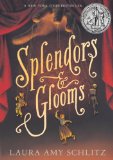Summary | Excerpt | Reviews | Beyond the Book | Read-Alikes | Genres & Themes | Author Bio

Critics' Opinion:
Readers' Opinion:
First Published:
Aug 2012, 400 pages
Paperback:
Jan 2014, 400 pages
 Book Reviewed by:
Book Reviewed by:
BJ Nathan Hegedus
Buy This Book
This article relates to Splendors and Glooms
In the early nineteenth century in England, parish churches and towns provided relief for the poor, but as the cost of looking after them kept rising and the method became increasingly disorganized, the upper classes and growing middle class who carried the burden of this expense by paying increasingly higher property taxes, sought a central alternative solution.
Parliament passed the Poor Law Amendment Act of 1834, which was meant to reduce this cost. The new law stated that in order to receive aid one needed to surrender everything (home, processions and most important, personal freedom) and move into the local parish workhouse. In return, one would be fed, clothed and given medical care. If this was not agreeable, no matter how destitute things became there would be no help given.
 Families forced to enter the workhouse were split apart. Husbands separated from wives, children from parents. Once segregated, everyone slept in dormitories. Residents had to wear uniforms and were referred to as inmates. Rules were enforced with punishments arbitrarily handed out by "matrons" and "masters," often in cruel and unjust ways.
Families forced to enter the workhouse were split apart. Husbands separated from wives, children from parents. Once segregated, everyone slept in dormitories. Residents had to wear uniforms and were referred to as inmates. Rules were enforced with punishments arbitrarily handed out by "matrons" and "masters," often in cruel and unjust ways.
Those inmates capable of work were expected to do so. Hours were long and physically taxing, consisting of such chores as breaking up rocks for building roads and smashing animal bones for fertilizer. The inmates also labored doing laundry, cooking and cleaning the workhouse.
Food was meagerly rationed, fruit, vegetables and milk nonexistent. Gruel was served twice daily. This poor diet when combined with unsafe and unhealthy living conditions made outbreaks of infections and disease a common occurrence. Yet this dismal place was often the only option left to children like Parsefall, orphaned with nowhere else to go. With no family to take them in, the workhouse, unlike the streets, at least offered shelter and something to eat.
In 1861, 35,000 children under the age of twelve lived and worked in workhouses throughout Great Britain. The children earned their keep by working alongside the adults. It was common practice for children to be "hired out" which in reality meant that they were sold to factories or mines as apprentices. Chimney sweeps found them useful because of their size.
Despite the very harsh conditions in the workhouse, this system did provide free health care and education for children, things the poor living outside the workhouses could not take for granted.
For Parsefall, the abysmal conditions he experienced working for Grisini were still better than those he probably would have had at the workhouse. And though he barely had enough to eat and his shoes were worn thin with holes at least as Grisini's apprentice, he was learning the art of puppetry.
Picture from Film Education
Filed under People, Eras & Events
![]() This "beyond the book article" relates to Splendors and Glooms. It originally ran in November 2012 and has been updated for the
January 2014 paperback edition.
Go to magazine.
This "beyond the book article" relates to Splendors and Glooms. It originally ran in November 2012 and has been updated for the
January 2014 paperback edition.
Go to magazine.





The Flower Sisters
by Michelle Collins Anderson
From the new Fannie Flagg of the Ozarks, a richly-woven story of family, forgiveness, and reinvention.

The House on Biscayne Bay
by Chanel Cleeton
As death stalks a gothic mansion in Miami, the lives of two women intertwine as the past and present collide.

The Funeral Cryer by Wenyan Lu
Debut novelist Wenyan Lu brings us this witty yet profound story about one woman's midlife reawakening in contemporary rural China.
Your guide toexceptional books
BookBrowse seeks out and recommends the best in contemporary fiction and nonfiction—books that not only engage and entertain but also deepen our understanding of ourselves and the world around us.